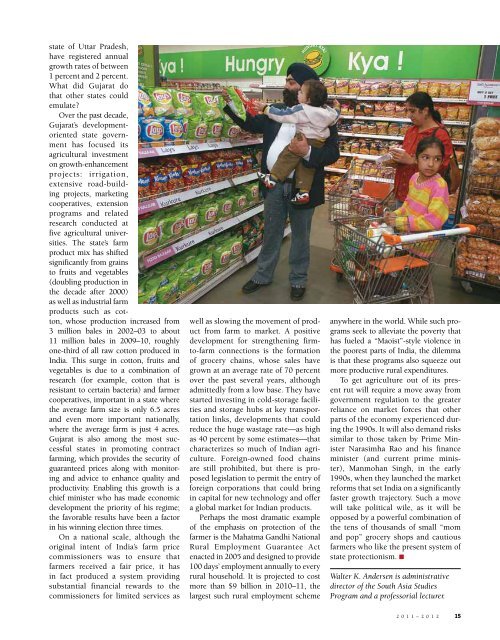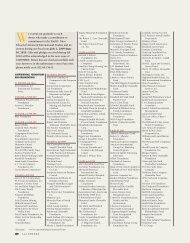Download Current Issue - SAIS
Download Current Issue - SAIS
Download Current Issue - SAIS
You also want an ePaper? Increase the reach of your titles
YUMPU automatically turns print PDFs into web optimized ePapers that Google loves.
state of Uttar Pradesh,<br />
have registered annual<br />
growth rates of between<br />
1 percent and 2 percent.<br />
What did Gujarat do<br />
that other states could<br />
emulate?<br />
Over the past decade,<br />
Gujarat’s developmentoriented<br />
state government<br />
has focused its<br />
agricultural investment<br />
on growth-enhancement<br />
projects: irrigation,<br />
extensive road-building<br />
projects, marketing<br />
cooperatives, extension<br />
programs and related<br />
research conducted at<br />
five agricultural universities.<br />
The state’s farm<br />
product mix has shifted<br />
significantly from grains<br />
to fruits and vegetables<br />
(doubling production in<br />
the decade after 2000)<br />
as well as industrial farm<br />
products such as cotton,<br />
whose production increased from<br />
3 million bales in 2002–03 to about<br />
11 million bales in 2009–10, roughly<br />
one-third of all raw cotton produced in<br />
India. This surge in cotton, fruits and<br />
vegetables is due to a combination of<br />
research (for example, cotton that is<br />
resistant to certain bacteria) and farmer<br />
cooperatives, important in a state where<br />
the average farm size is only 6.5 acres<br />
and even more important nationally,<br />
where the average farm is just 4 acres.<br />
Gujarat is also among the most successful<br />
states in promoting contract<br />
farming, which provides the security of<br />
guaranteed prices along with monitoring<br />
and advice to enhance quality and<br />
productivity. Enabling this growth is a<br />
chief minister who has made economic<br />
development the priority of his regime;<br />
the favorable results have been a factor<br />
in his winning election three times.<br />
On a national scale, although the<br />
original intent of India’s farm price<br />
commissioners was to ensure that<br />
farmers received a fair price, it has<br />
in fact produced a system providing<br />
substantial financial rewards to the<br />
commissioners for limited services as<br />
well as slowing the movement of product<br />
from farm to market. A positive<br />
development for strengthening firmto-farm<br />
connections is the formation<br />
of grocery chains, whose sales have<br />
grown at an average rate of 70 percent<br />
over the past several years, although<br />
admittedly from a low base. They have<br />
started investing in cold-storage facilities<br />
and storage hubs at key transportation<br />
links, developments that could<br />
reduce the huge wastage rate—as high<br />
as 40 percent by some estimates—that<br />
characterizes so much of Indian agriculture.<br />
Foreign-owned food chains<br />
are still prohibited, but there is proposed<br />
legislation to permit the entry of<br />
foreign corporations that could bring<br />
in capital for new technology and offer<br />
a global market for Indian products.<br />
Perhaps the most dramatic example<br />
of the emphasis on protection of the<br />
farmer is the Mahatma Gandhi National<br />
Rural Employment Guarantee Act<br />
enacted in 2005 and designed to provide<br />
100 days’ employment annually to every<br />
rural household. It is projected to cost<br />
more than $9 billion in 2010–11, the<br />
largest such rural employment scheme<br />
anywhere in the world. While such programs<br />
seek to alleviate the poverty that<br />
has fueled a “Maoist”-style violence in<br />
the poorest parts of India, the dilemma<br />
is that these programs also squeeze out<br />
more productive rural expenditures.<br />
To get agriculture out of its present<br />
rut will require a move away from<br />
government regulation to the greater<br />
reliance on market forces that other<br />
parts of the economy experienced during<br />
the 1990s. It will also demand risks<br />
similar to those taken by Prime Minister<br />
Narasimha Rao and his finance<br />
minister (and current prime minister),<br />
Manmohan Singh, in the early<br />
1990s, when they launched the market<br />
reforms that set India on a significantly<br />
faster growth trajectory. Such a move<br />
will take political wile, as it will be<br />
opposed by a powerful combination of<br />
the tens of thousands of small “mom<br />
and pop” grocery shops and cautious<br />
farmers who like the present system of<br />
state protectionism. n<br />
Walter K. Andersen is administrative<br />
director of the South Asia Studies<br />
Program and a professorial lecturer.<br />
2011–2012 15



